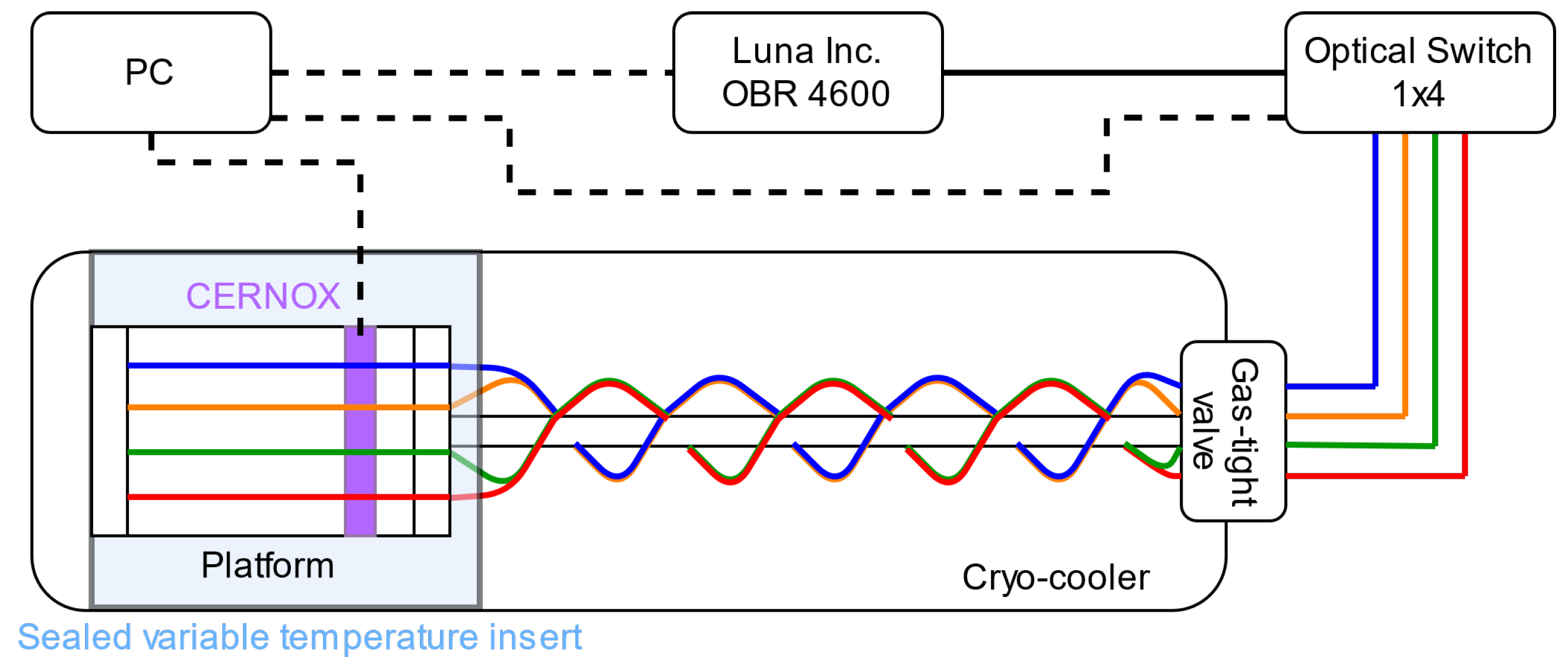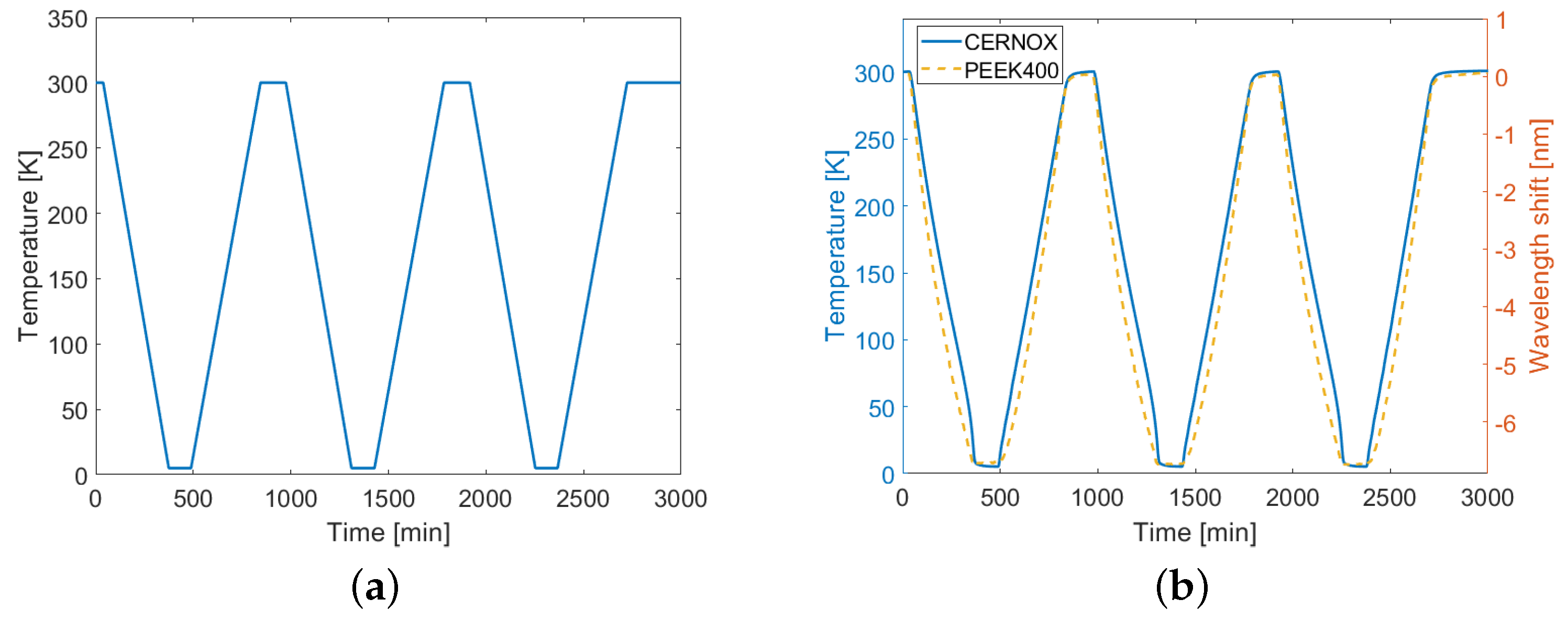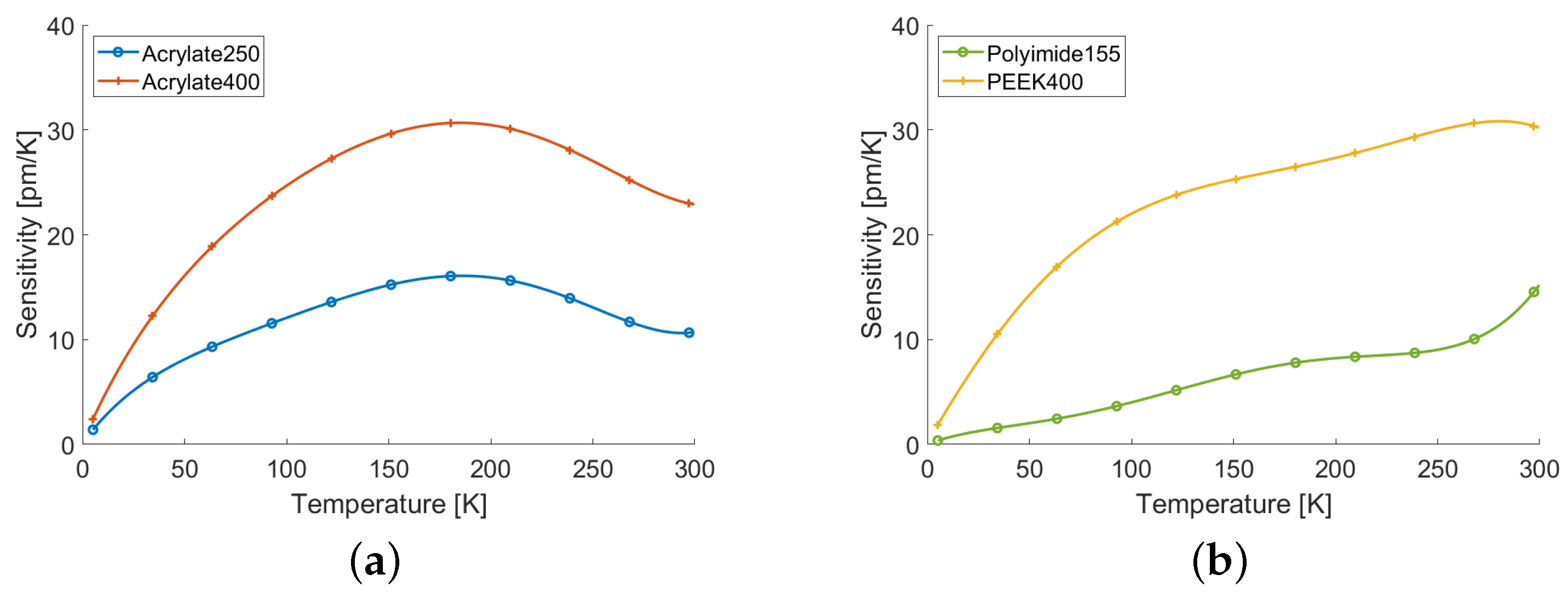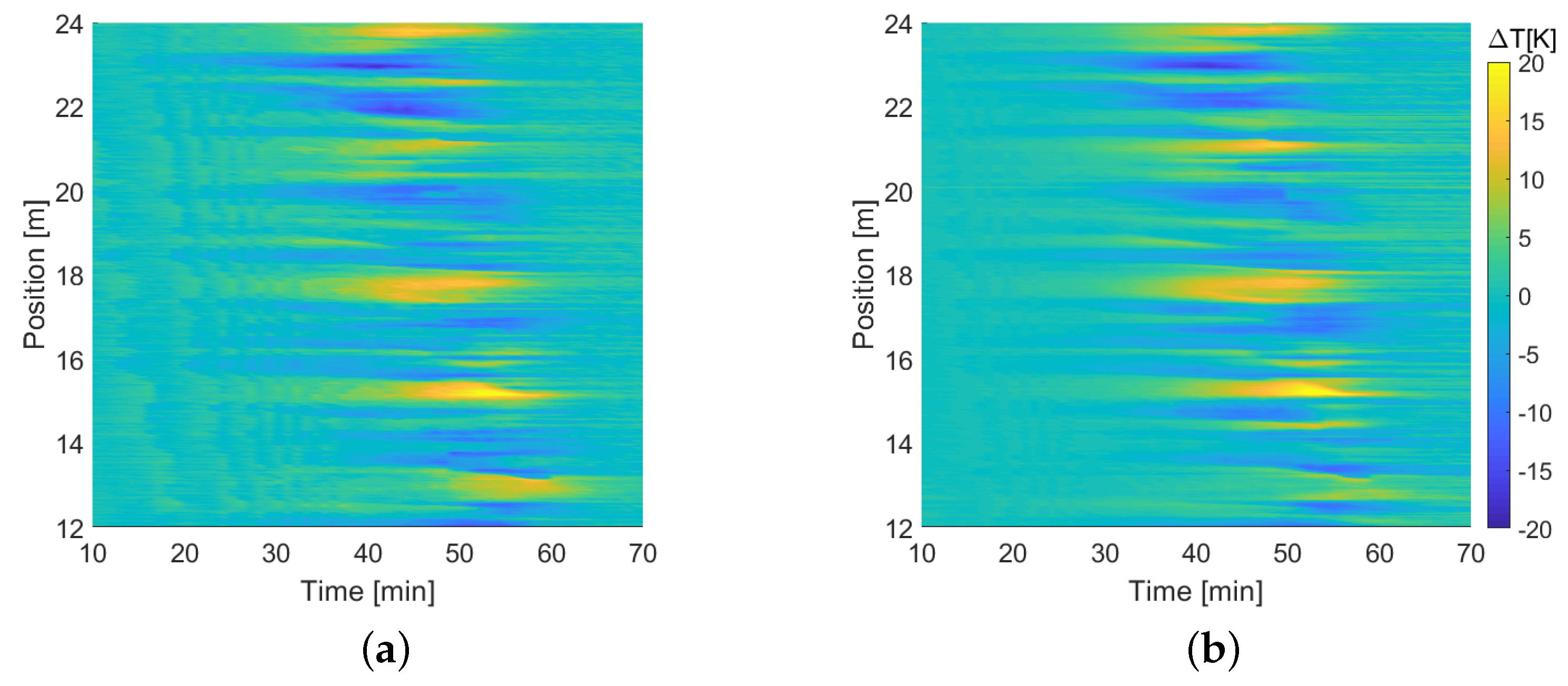The Characterization of Optical Fibers for Distributed Cryogenic Temperature Monitoring
Abstract
1. Introduction
2. Overview of the Technique and of the Theoretical Model
3. Experimental Characterization of the Fibers’ Thermal Responses
3.1. Experimental Setup
3.2. Results
4. Superconducting Link
4.1. Experimental Setup
4.2. Results
5. Conclusions
Author Contributions
Funding
Informed Consent Statement
Data Availability Statement
Acknowledgments
Conflicts of Interest
References
- van Nugteren, J.; Kirby, G.; Bajas, H.; Bajko, M.; Ballarino, A.; Bottura, L.; Chiuchiolo, A.; Contat, P.-A.; Dhallé, M.; Durante, M.; et al. Powering of an HTS dipole insert-magnet operated standalone in helium gas between 5 and 85 K. Supercond. Sci. Technol. 2018, 31, 065002. [Google Scholar] [CrossRef]
- Chiuchiolo, A.; Palmieri, L.; Consales, M.; Giordano, M.; Borriello, A.; Bajas, H.; Galtarossa, A.; Bajko, M.; Cusano, A. Cryogenic-temperature profiling of high-power superconducting lines using local and distributed optical-fiber sensors. Opt. Lett. 2015, 40, 4424. [Google Scholar] [CrossRef] [PubMed]
- Boyd, C.D.; Dickerson, B.D.; Fitzpatrick, B.K. Monitoring distributed temperatures along superconducting degaussing cables via Rayleigh backscattering in optical fibers. In Proceedings of the Intelligent Ships Symposium IX, Philadelphia, PA, USA, 25–26 May 2011. [Google Scholar]
- Thevenaz, L.; Fellay, A.; Facchini, M.; Scandale, W.; Nikles, M.; Robert, P.A. Brillouin optical fiber sensor for cryogenic thermometry. In Proceedings of the SPIE’s 9th Annual International Symposium on Smart Structures and Materials, San Diego, CA, USA, 1 July 2002; pp. 22–27. [Google Scholar]
- Scurti, F.; Ishmael, S.; Flanagan, G.; Schwartz, J. Quench detection for high temperature superconductor magnets: A novel technique based on Rayleigh-backscattering interrogated optical fibers. Supercond. Sci. Technol. 2016, 29, 03LT01. [Google Scholar] [CrossRef]
- Marcon, L.; Galtarossa, A.; Palmieri, L. High-frequency high-resolution distributed acoustic sensing by optical frequency domain reflectometry. Opt. Express 2019, 27, 13923. [Google Scholar] [CrossRef] [PubMed]
- Zhang, H.; Deng, F.; Wang, Q.; Yan, L.; Dai, Y.; Kim, K. Development of Strain Measurement in Superconducting Magnet Through Fiber Bragg Grating. IEEE Trans. Appl. Supercond. 2008, 18, 1419–1422. [Google Scholar] [CrossRef]
- Chiuchiolo, A.; Bajko, M.; Perez, J.C.; Bajas, H.; Consales, M.; Giordano, M.; Breglio, G.; Cusano, A. Fiber Bragg Grating Cryosensors for Superconducting Accelerator Magnets. IEEE Photonics J. 2014, 6, 1–10. [Google Scholar] [CrossRef]
- Gupta, S.; Mizunami, T.; Yamao, T.; Shimomura, T. Fiber Bragg grating cryogenic temperature sensors. Appl. Opt. 1996, 35, 5202. [Google Scholar] [CrossRef] [PubMed]
- Rossi, L. Toward a new paradigm in quench detection for superconducting magnets? ‘Quench detection for high temperature superconductor magnets: A novel technique based on Rayleigh-backscattering interrogated optical fibers (RIOF)’. Supercond. Sci. Technol. 2016, 29, 060501. [Google Scholar] [CrossRef]
- Scurti, F.; Sathyamurthy, S.; Rupich, M.; Schwartz, J. Self-monitoring ‘SMART’ (RE)Ba2Cu3O7−x conductor via integrated optical fibers. Supercond. Sci. Technol. 2017, 30, 114002. [Google Scholar] [CrossRef]
- Marcon, L. Thermal response characterization of different optical fibers samples at cryogenic temperatures. In Proceedings of the Optical Fiber Sensors Conference 2020 Special Edition (2020), Alexandria, VI, USA, 8 June 2020; p. T3.71. [Google Scholar]
- Buric, M.; Ohodnicki, P.; Yan, A.; Huang, S.; Chen, K.P. Distributed fiber-optic sensing in a high-temperature solid-oxide fuel cell. In Proceedings of the Remote Sensing System Engineering VI, San Diego, CA, USA, 31 August–1 September 2016; Volume 9977, p. 997708. [Google Scholar]
- Gifford, D.K.; Froggatt, M.E.; Kreger, S.T. High precision, high sensitivity distributed displacement and temperature measurements using OFDR-based phase tracking. In Proceedings of the 21st International Conference on Optical Fibre Sensors, Ottawa, ON, Canada, 17 May 2011; Volume 7753, p. 77533I-4. [Google Scholar]
- Evans, B.; Down, R.; Keeping, J.; Kirichek, O.; Bowden, Z. Cryogen-free low temperature sample environment for neutron scattering based on pulse tube refrigeration. Meas. Sci. Technol. 2008, 19, 034018. [Google Scholar] [CrossRef]
- Ballarino, A. Development of superconducting links for the Large Hadron Collider machine. Supercond. Sci. Technol. 2014, 27, 044024. [Google Scholar] [CrossRef]
- Ballarino, A. Prospects for the use of HTS in High-field Magnets for Future Accelerator Facilities. In Proceedings of the 5th International Particle Accelerator Conference IPAC2014, Dresden, Germany, 15–20 June 2014; p. TUZB02. [Google Scholar]
- Ballarino, A. Alternative Design Concepts for Multi-Circuit HTS Link Systems. IEEE Trans. Appl. Supercond. 2011, 21, 980–984. [Google Scholar] [CrossRef][Green Version]











| Label | Coating Polymer | Coating Thickness [m] | Fiber Total Diameter [m] |
|---|---|---|---|
| Acrylate250 | Acrylate | 62.5 | 250 |
| Acrylate400 | Acrylate | 137.5 | 400 |
| Polyimide155 | Polyimide | 15.0 | 155 |
| PEEK400 | Polyether–ether–ketone (PEEK) | 137.5 | 400 |
| Acrylate250 | Acrylate400 | PEEK400 | Polyimide155 | |
|---|---|---|---|---|
| Max. difference among cycles | 0.051 nm | 0.072 nm | 0.077 nm | 0.037 nm |
| 1.46% | 1.02% | 1.14% | 2.03% | |
| Interpolation residual (RMS) | 0.0077 nm | 0.0084 nm | 0.0096 nm | 0.0087 nm |
| 0.22% | 0.12% | 0.52% | 0.12% |
Publisher’s Note: MDPI stays neutral with regard to jurisdictional claims in published maps and institutional affiliations. |
© 2022 by the authors. Licensee MDPI, Basel, Switzerland. This article is an open access article distributed under the terms and conditions of the Creative Commons Attribution (CC BY) license (https://creativecommons.org/licenses/by/4.0/).
Share and Cite
Marcon, L.; Chiuchiolo, A.; Castaldo, B.; Bajas, H.; Galtarossa, A.; Bajko, M.; Palmieri, L. The Characterization of Optical Fibers for Distributed Cryogenic Temperature Monitoring. Sensors 2022, 22, 4009. https://doi.org/10.3390/s22114009
Marcon L, Chiuchiolo A, Castaldo B, Bajas H, Galtarossa A, Bajko M, Palmieri L. The Characterization of Optical Fibers for Distributed Cryogenic Temperature Monitoring. Sensors. 2022; 22(11):4009. https://doi.org/10.3390/s22114009
Chicago/Turabian StyleMarcon, Leonardo, Antonella Chiuchiolo, Bernardo Castaldo, Hugues Bajas, Andrea Galtarossa, Marta Bajko, and Luca Palmieri. 2022. "The Characterization of Optical Fibers for Distributed Cryogenic Temperature Monitoring" Sensors 22, no. 11: 4009. https://doi.org/10.3390/s22114009
APA StyleMarcon, L., Chiuchiolo, A., Castaldo, B., Bajas, H., Galtarossa, A., Bajko, M., & Palmieri, L. (2022). The Characterization of Optical Fibers for Distributed Cryogenic Temperature Monitoring. Sensors, 22(11), 4009. https://doi.org/10.3390/s22114009






